Evaluation of Practices in Teaching, Learning and Assessment
VerifiedAdded on 2022/12/30
|10
|2820
|27
Report
AI Summary
This report evaluates teaching, learning, and assessment practices, examining them through various theoretical perspectives. It explores the impact of digital learning programs, highlighting both psychological processes and the benefits of technology in education. The report delves into different learning approaches, including cognitive and embodied cognition, with examples of projects like Block Magic and INF@NZIA DIGI.tales 3.6. It discusses behaviorist and cognitive learning theories, situated learning, and the role of the body in cognition. The report also touches upon the influence of technology on educational practices, the importance of continuous learning, and the role of experience in shaping behavior and knowledge acquisition. The conclusion emphasizes the connection between psychological processes, technology, and the evolving landscape of education.
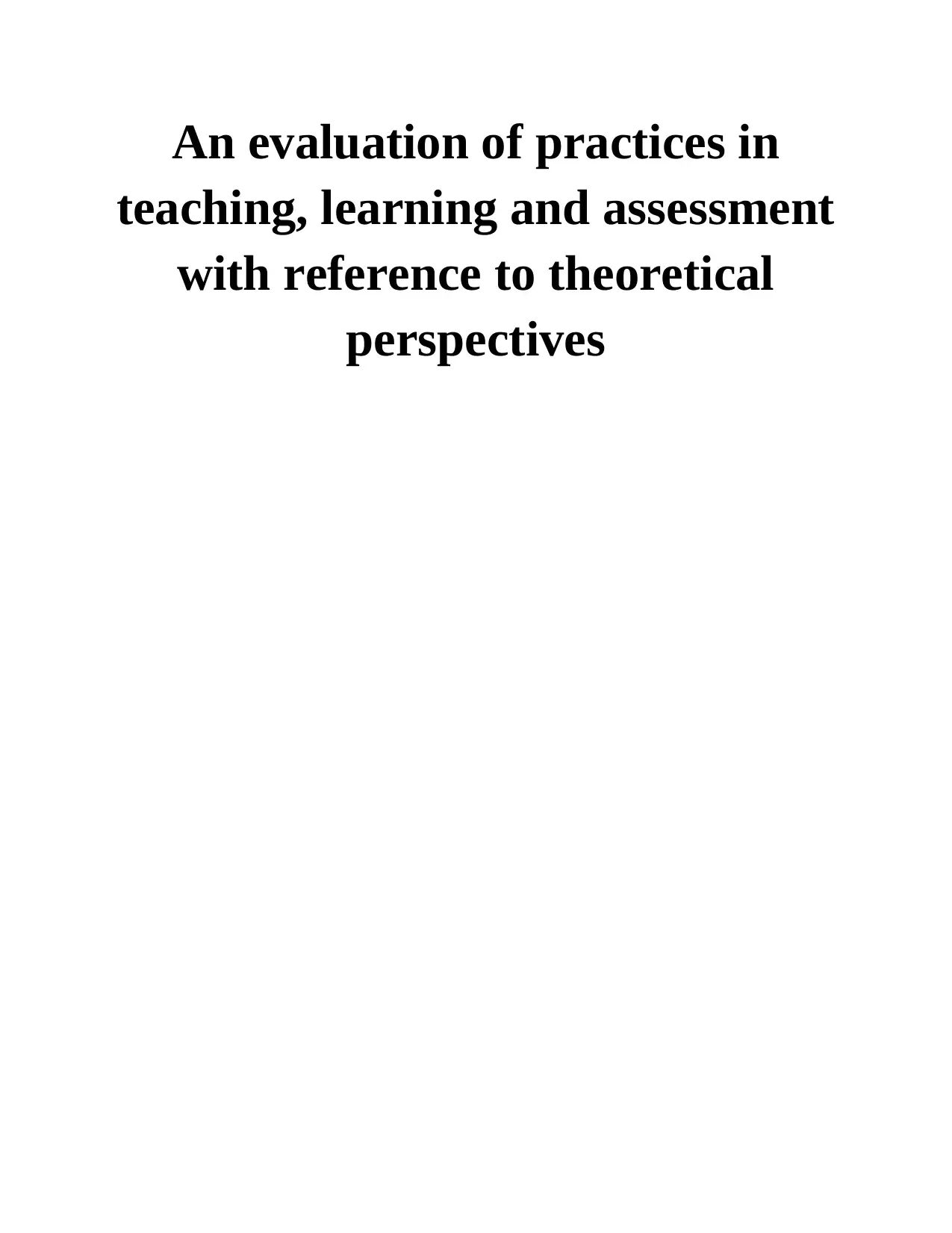
An evaluation of practices in
teaching, learning and assessment
with reference to theoretical
perspectives
teaching, learning and assessment
with reference to theoretical
perspectives
Paraphrase This Document
Need a fresh take? Get an instant paraphrase of this document with our AI Paraphraser

INTRODUCTION.......................................................................................................................................3
MAIN BODY..............................................................................................................................................3
CONCLUSION...........................................................................................................................................3
REFERNCES..............................................................................................................................................4
MAIN BODY..............................................................................................................................................3
CONCLUSION...........................................................................................................................................3
REFERNCES..............................................................................................................................................4
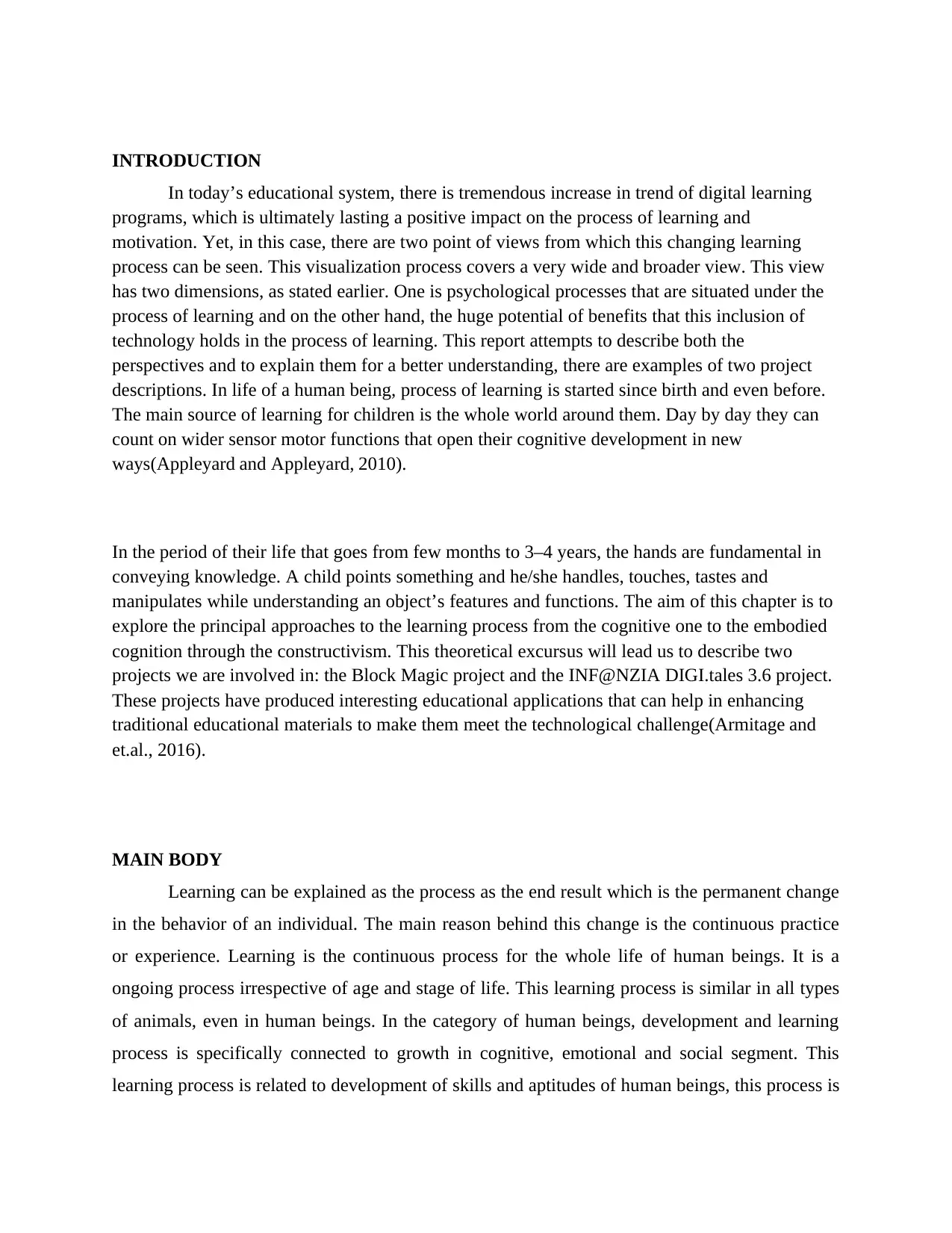
INTRODUCTION
In today’s educational system, there is tremendous increase in trend of digital learning
programs, which is ultimately lasting a positive impact on the process of learning and
motivation. Yet, in this case, there are two point of views from which this changing learning
process can be seen. This visualization process covers a very wide and broader view. This view
has two dimensions, as stated earlier. One is psychological processes that are situated under the
process of learning and on the other hand, the huge potential of benefits that this inclusion of
technology holds in the process of learning. This report attempts to describe both the
perspectives and to explain them for a better understanding, there are examples of two project
descriptions. In life of a human being, process of learning is started since birth and even before.
The main source of learning for children is the whole world around them. Day by day they can
count on wider sensor motor functions that open their cognitive development in new
ways(Appleyard and Appleyard, 2010).
In the period of their life that goes from few months to 3–4 years, the hands are fundamental in
conveying knowledge. A child points something and he/she handles, touches, tastes and
manipulates while understanding an object’s features and functions. The aim of this chapter is to
explore the principal approaches to the learning process from the cognitive one to the embodied
cognition through the constructivism. This theoretical excursus will lead us to describe two
projects we are involved in: the Block Magic project and the INF@NZIA DIGI.tales 3.6 project.
These projects have produced interesting educational applications that can help in enhancing
traditional educational materials to make them meet the technological challenge(Armitage and
et.al., 2016).
MAIN BODY
Learning can be explained as the process as the end result which is the permanent change
in the behavior of an individual. The main reason behind this change is the continuous practice
or experience. Learning is the continuous process for the whole life of human beings. It is a
ongoing process irrespective of age and stage of life. This learning process is similar in all types
of animals, even in human beings. In the category of human beings, development and learning
process is specifically connected to growth in cognitive, emotional and social segment. This
learning process is related to development of skills and aptitudes of human beings, this process is
In today’s educational system, there is tremendous increase in trend of digital learning
programs, which is ultimately lasting a positive impact on the process of learning and
motivation. Yet, in this case, there are two point of views from which this changing learning
process can be seen. This visualization process covers a very wide and broader view. This view
has two dimensions, as stated earlier. One is psychological processes that are situated under the
process of learning and on the other hand, the huge potential of benefits that this inclusion of
technology holds in the process of learning. This report attempts to describe both the
perspectives and to explain them for a better understanding, there are examples of two project
descriptions. In life of a human being, process of learning is started since birth and even before.
The main source of learning for children is the whole world around them. Day by day they can
count on wider sensor motor functions that open their cognitive development in new
ways(Appleyard and Appleyard, 2010).
In the period of their life that goes from few months to 3–4 years, the hands are fundamental in
conveying knowledge. A child points something and he/she handles, touches, tastes and
manipulates while understanding an object’s features and functions. The aim of this chapter is to
explore the principal approaches to the learning process from the cognitive one to the embodied
cognition through the constructivism. This theoretical excursus will lead us to describe two
projects we are involved in: the Block Magic project and the INF@NZIA DIGI.tales 3.6 project.
These projects have produced interesting educational applications that can help in enhancing
traditional educational materials to make them meet the technological challenge(Armitage and
et.al., 2016).
MAIN BODY
Learning can be explained as the process as the end result which is the permanent change
in the behavior of an individual. The main reason behind this change is the continuous practice
or experience. Learning is the continuous process for the whole life of human beings. It is a
ongoing process irrespective of age and stage of life. This learning process is similar in all types
of animals, even in human beings. In the category of human beings, development and learning
process is specifically connected to growth in cognitive, emotional and social segment. This
learning process is related to development of skills and aptitudes of human beings, this process is
⊘ This is a preview!⊘
Do you want full access?
Subscribe today to unlock all pages.

Trusted by 1+ million students worldwide
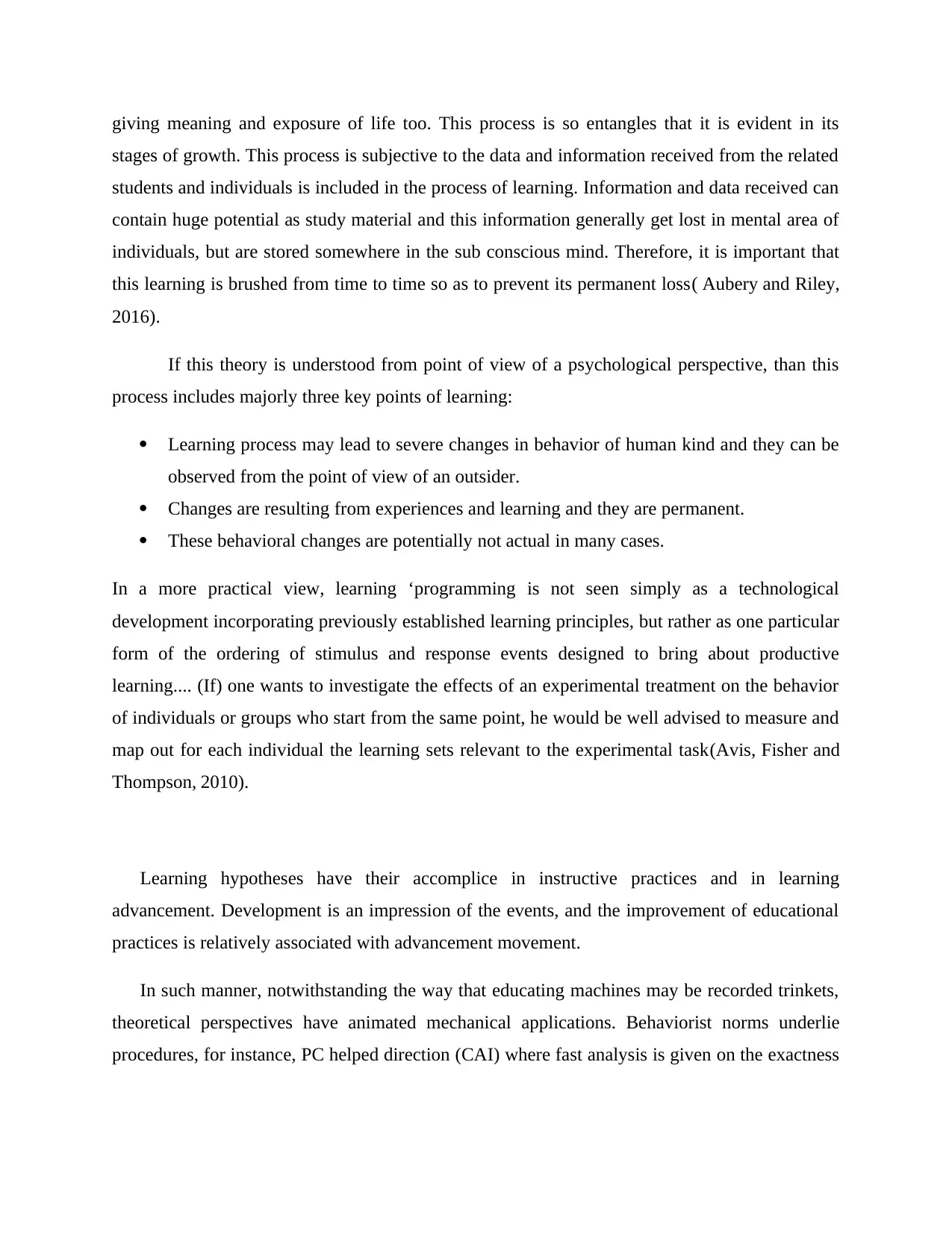
giving meaning and exposure of life too. This process is so entangles that it is evident in its
stages of growth. This process is subjective to the data and information received from the related
students and individuals is included in the process of learning. Information and data received can
contain huge potential as study material and this information generally get lost in mental area of
individuals, but are stored somewhere in the sub conscious mind. Therefore, it is important that
this learning is brushed from time to time so as to prevent its permanent loss( Aubery and Riley,
2016).
If this theory is understood from point of view of a psychological perspective, than this
process includes majorly three key points of learning:
Learning process may lead to severe changes in behavior of human kind and they can be
observed from the point of view of an outsider.
Changes are resulting from experiences and learning and they are permanent.
These behavioral changes are potentially not actual in many cases.
In a more practical view, learning ‘programming is not seen simply as a technological
development incorporating previously established learning principles, but rather as one particular
form of the ordering of stimulus and response events designed to bring about productive
learning.... (If) one wants to investigate the effects of an experimental treatment on the behavior
of individuals or groups who start from the same point, he would be well advised to measure and
map out for each individual the learning sets relevant to the experimental task(Avis, Fisher and
Thompson, 2010).
Learning hypotheses have their accomplice in instructive practices and in learning
advancement. Development is an impression of the events, and the improvement of educational
practices is relatively associated with advancement movement.
In such manner, notwithstanding the way that educating machines may be recorded trinkets,
theoretical perspectives have animated mechanical applications. Behaviorist norms underlie
procedures, for instance, PC helped direction (CAI) where fast analysis is given on the exactness
stages of growth. This process is subjective to the data and information received from the related
students and individuals is included in the process of learning. Information and data received can
contain huge potential as study material and this information generally get lost in mental area of
individuals, but are stored somewhere in the sub conscious mind. Therefore, it is important that
this learning is brushed from time to time so as to prevent its permanent loss( Aubery and Riley,
2016).
If this theory is understood from point of view of a psychological perspective, than this
process includes majorly three key points of learning:
Learning process may lead to severe changes in behavior of human kind and they can be
observed from the point of view of an outsider.
Changes are resulting from experiences and learning and they are permanent.
These behavioral changes are potentially not actual in many cases.
In a more practical view, learning ‘programming is not seen simply as a technological
development incorporating previously established learning principles, but rather as one particular
form of the ordering of stimulus and response events designed to bring about productive
learning.... (If) one wants to investigate the effects of an experimental treatment on the behavior
of individuals or groups who start from the same point, he would be well advised to measure and
map out for each individual the learning sets relevant to the experimental task(Avis, Fisher and
Thompson, 2010).
Learning hypotheses have their accomplice in instructive practices and in learning
advancement. Development is an impression of the events, and the improvement of educational
practices is relatively associated with advancement movement.
In such manner, notwithstanding the way that educating machines may be recorded trinkets,
theoretical perspectives have animated mechanical applications. Behaviorist norms underlie
procedures, for instance, PC helped direction (CAI) where fast analysis is given on the exactness
Paraphrase This Document
Need a fresh take? Get an instant paraphrase of this document with our AI Paraphraser
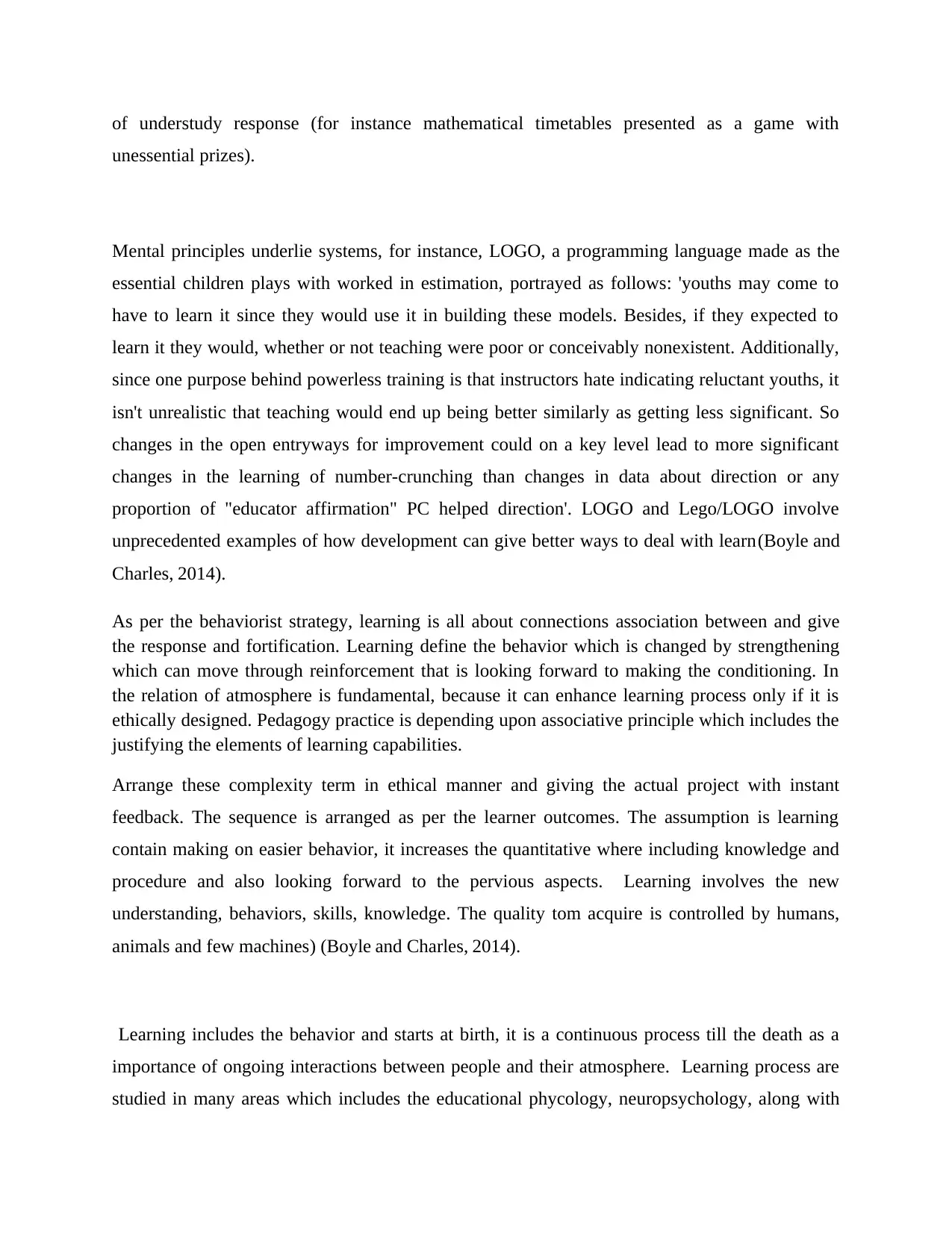
of understudy response (for instance mathematical timetables presented as a game with
unessential prizes).
Mental principles underlie systems, for instance, LOGO, a programming language made as the
essential children plays with worked in estimation, portrayed as follows: 'youths may come to
have to learn it since they would use it in building these models. Besides, if they expected to
learn it they would, whether or not teaching were poor or conceivably nonexistent. Additionally,
since one purpose behind powerless training is that instructors hate indicating reluctant youths, it
isn't unrealistic that teaching would end up being better similarly as getting less significant. So
changes in the open entryways for improvement could on a key level lead to more significant
changes in the learning of number-crunching than changes in data about direction or any
proportion of "educator affirmation" PC helped direction'. LOGO and Lego/LOGO involve
unprecedented examples of how development can give better ways to deal with learn(Boyle and
Charles, 2014).
As per the behaviorist strategy, learning is all about connections association between and give
the response and fortification. Learning define the behavior which is changed by strengthening
which can move through reinforcement that is looking forward to making the conditioning. In
the relation of atmosphere is fundamental, because it can enhance learning process only if it is
ethically designed. Pedagogy practice is depending upon associative principle which includes the
justifying the elements of learning capabilities.
Arrange these complexity term in ethical manner and giving the actual project with instant
feedback. The sequence is arranged as per the learner outcomes. The assumption is learning
contain making on easier behavior, it increases the quantitative where including knowledge and
procedure and also looking forward to the pervious aspects. Learning involves the new
understanding, behaviors, skills, knowledge. The quality tom acquire is controlled by humans,
animals and few machines) (Boyle and Charles, 2014).
Learning includes the behavior and starts at birth, it is a continuous process till the death as a
importance of ongoing interactions between people and their atmosphere. Learning process are
studied in many areas which includes the educational phycology, neuropsychology, along with
unessential prizes).
Mental principles underlie systems, for instance, LOGO, a programming language made as the
essential children plays with worked in estimation, portrayed as follows: 'youths may come to
have to learn it since they would use it in building these models. Besides, if they expected to
learn it they would, whether or not teaching were poor or conceivably nonexistent. Additionally,
since one purpose behind powerless training is that instructors hate indicating reluctant youths, it
isn't unrealistic that teaching would end up being better similarly as getting less significant. So
changes in the open entryways for improvement could on a key level lead to more significant
changes in the learning of number-crunching than changes in data about direction or any
proportion of "educator affirmation" PC helped direction'. LOGO and Lego/LOGO involve
unprecedented examples of how development can give better ways to deal with learn(Boyle and
Charles, 2014).
As per the behaviorist strategy, learning is all about connections association between and give
the response and fortification. Learning define the behavior which is changed by strengthening
which can move through reinforcement that is looking forward to making the conditioning. In
the relation of atmosphere is fundamental, because it can enhance learning process only if it is
ethically designed. Pedagogy practice is depending upon associative principle which includes the
justifying the elements of learning capabilities.
Arrange these complexity term in ethical manner and giving the actual project with instant
feedback. The sequence is arranged as per the learner outcomes. The assumption is learning
contain making on easier behavior, it increases the quantitative where including knowledge and
procedure and also looking forward to the pervious aspects. Learning involves the new
understanding, behaviors, skills, knowledge. The quality tom acquire is controlled by humans,
animals and few machines) (Boyle and Charles, 2014).
Learning includes the behavior and starts at birth, it is a continuous process till the death as a
importance of ongoing interactions between people and their atmosphere. Learning process are
studied in many areas which includes the educational phycology, neuropsychology, along with
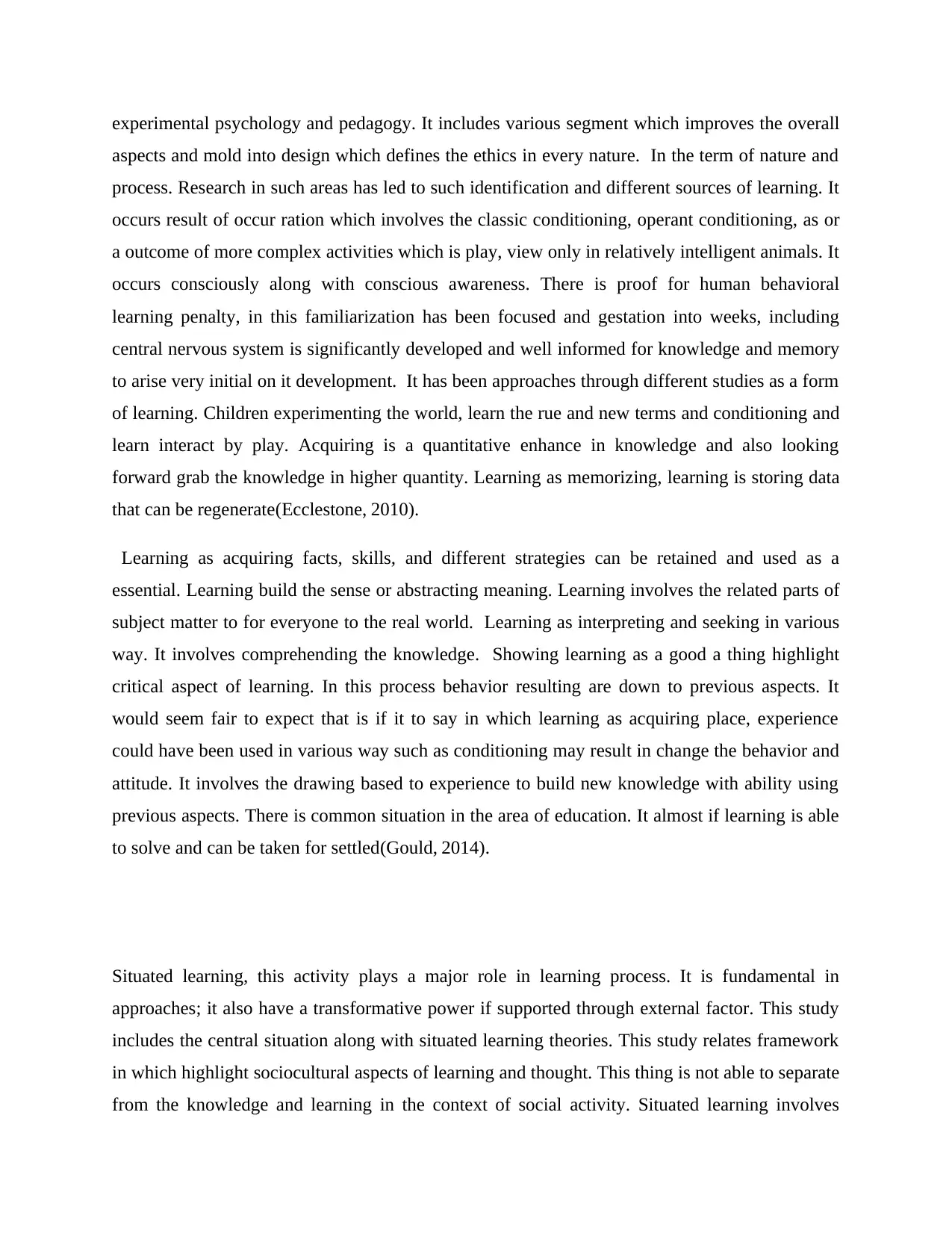
experimental psychology and pedagogy. It includes various segment which improves the overall
aspects and mold into design which defines the ethics in every nature. In the term of nature and
process. Research in such areas has led to such identification and different sources of learning. It
occurs result of occur ration which involves the classic conditioning, operant conditioning, as or
a outcome of more complex activities which is play, view only in relatively intelligent animals. It
occurs consciously along with conscious awareness. There is proof for human behavioral
learning penalty, in this familiarization has been focused and gestation into weeks, including
central nervous system is significantly developed and well informed for knowledge and memory
to arise very initial on it development. It has been approaches through different studies as a form
of learning. Children experimenting the world, learn the rue and new terms and conditioning and
learn interact by play. Acquiring is a quantitative enhance in knowledge and also looking
forward grab the knowledge in higher quantity. Learning as memorizing, learning is storing data
that can be regenerate(Ecclestone, 2010).
Learning as acquiring facts, skills, and different strategies can be retained and used as a
essential. Learning build the sense or abstracting meaning. Learning involves the related parts of
subject matter to for everyone to the real world. Learning as interpreting and seeking in various
way. It involves comprehending the knowledge. Showing learning as a good a thing highlight
critical aspect of learning. In this process behavior resulting are down to previous aspects. It
would seem fair to expect that is if it to say in which learning as acquiring place, experience
could have been used in various way such as conditioning may result in change the behavior and
attitude. It involves the drawing based to experience to build new knowledge with ability using
previous aspects. There is common situation in the area of education. It almost if learning is able
to solve and can be taken for settled(Gould, 2014).
Situated learning, this activity plays a major role in learning process. It is fundamental in
approaches; it also have a transformative power if supported through external factor. This study
includes the central situation along with situated learning theories. This study relates framework
in which highlight sociocultural aspects of learning and thought. This thing is not able to separate
from the knowledge and learning in the context of social activity. Situated learning involves
aspects and mold into design which defines the ethics in every nature. In the term of nature and
process. Research in such areas has led to such identification and different sources of learning. It
occurs result of occur ration which involves the classic conditioning, operant conditioning, as or
a outcome of more complex activities which is play, view only in relatively intelligent animals. It
occurs consciously along with conscious awareness. There is proof for human behavioral
learning penalty, in this familiarization has been focused and gestation into weeks, including
central nervous system is significantly developed and well informed for knowledge and memory
to arise very initial on it development. It has been approaches through different studies as a form
of learning. Children experimenting the world, learn the rue and new terms and conditioning and
learn interact by play. Acquiring is a quantitative enhance in knowledge and also looking
forward grab the knowledge in higher quantity. Learning as memorizing, learning is storing data
that can be regenerate(Ecclestone, 2010).
Learning as acquiring facts, skills, and different strategies can be retained and used as a
essential. Learning build the sense or abstracting meaning. Learning involves the related parts of
subject matter to for everyone to the real world. Learning as interpreting and seeking in various
way. It involves comprehending the knowledge. Showing learning as a good a thing highlight
critical aspect of learning. In this process behavior resulting are down to previous aspects. It
would seem fair to expect that is if it to say in which learning as acquiring place, experience
could have been used in various way such as conditioning may result in change the behavior and
attitude. It involves the drawing based to experience to build new knowledge with ability using
previous aspects. There is common situation in the area of education. It almost if learning is able
to solve and can be taken for settled(Gould, 2014).
Situated learning, this activity plays a major role in learning process. It is fundamental in
approaches; it also have a transformative power if supported through external factor. This study
includes the central situation along with situated learning theories. This study relates framework
in which highlight sociocultural aspects of learning and thought. This thing is not able to separate
from the knowledge and learning in the context of social activity. Situated learning involves
⊘ This is a preview!⊘
Do you want full access?
Subscribe today to unlock all pages.

Trusted by 1+ million students worldwide
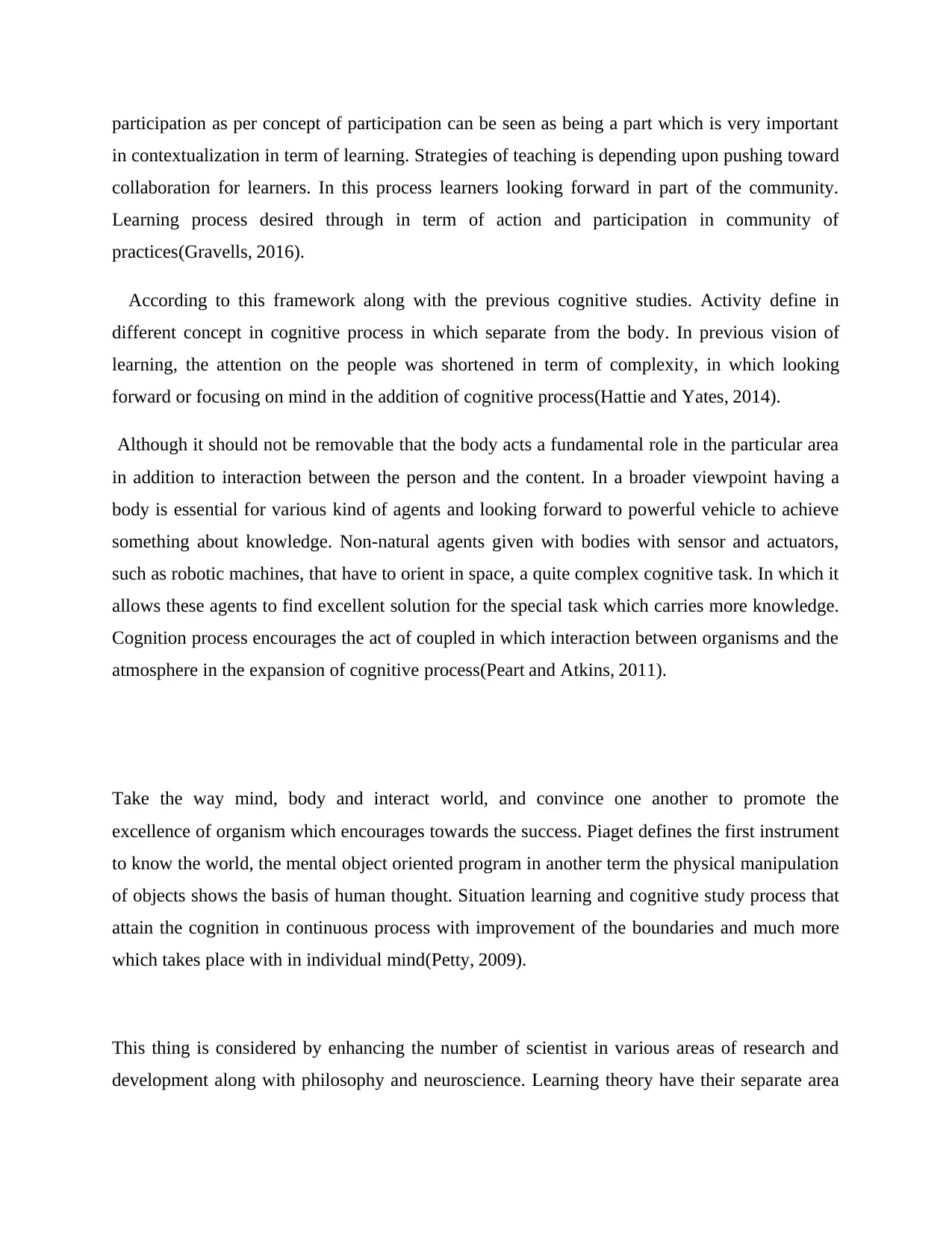
participation as per concept of participation can be seen as being a part which is very important
in contextualization in term of learning. Strategies of teaching is depending upon pushing toward
collaboration for learners. In this process learners looking forward in part of the community.
Learning process desired through in term of action and participation in community of
practices(Gravells, 2016).
According to this framework along with the previous cognitive studies. Activity define in
different concept in cognitive process in which separate from the body. In previous vision of
learning, the attention on the people was shortened in term of complexity, in which looking
forward or focusing on mind in the addition of cognitive process(Hattie and Yates, 2014).
Although it should not be removable that the body acts a fundamental role in the particular area
in addition to interaction between the person and the content. In a broader viewpoint having a
body is essential for various kind of agents and looking forward to powerful vehicle to achieve
something about knowledge. Non-natural agents given with bodies with sensor and actuators,
such as robotic machines, that have to orient in space, a quite complex cognitive task. In which it
allows these agents to find excellent solution for the special task which carries more knowledge.
Cognition process encourages the act of coupled in which interaction between organisms and the
atmosphere in the expansion of cognitive process(Peart and Atkins, 2011).
Take the way mind, body and interact world, and convince one another to promote the
excellence of organism which encourages towards the success. Piaget defines the first instrument
to know the world, the mental object oriented program in another term the physical manipulation
of objects shows the basis of human thought. Situation learning and cognitive study process that
attain the cognition in continuous process with improvement of the boundaries and much more
which takes place with in individual mind(Petty, 2009).
This thing is considered by enhancing the number of scientist in various areas of research and
development along with philosophy and neuroscience. Learning theory have their separate area
in contextualization in term of learning. Strategies of teaching is depending upon pushing toward
collaboration for learners. In this process learners looking forward in part of the community.
Learning process desired through in term of action and participation in community of
practices(Gravells, 2016).
According to this framework along with the previous cognitive studies. Activity define in
different concept in cognitive process in which separate from the body. In previous vision of
learning, the attention on the people was shortened in term of complexity, in which looking
forward or focusing on mind in the addition of cognitive process(Hattie and Yates, 2014).
Although it should not be removable that the body acts a fundamental role in the particular area
in addition to interaction between the person and the content. In a broader viewpoint having a
body is essential for various kind of agents and looking forward to powerful vehicle to achieve
something about knowledge. Non-natural agents given with bodies with sensor and actuators,
such as robotic machines, that have to orient in space, a quite complex cognitive task. In which it
allows these agents to find excellent solution for the special task which carries more knowledge.
Cognition process encourages the act of coupled in which interaction between organisms and the
atmosphere in the expansion of cognitive process(Peart and Atkins, 2011).
Take the way mind, body and interact world, and convince one another to promote the
excellence of organism which encourages towards the success. Piaget defines the first instrument
to know the world, the mental object oriented program in another term the physical manipulation
of objects shows the basis of human thought. Situation learning and cognitive study process that
attain the cognition in continuous process with improvement of the boundaries and much more
which takes place with in individual mind(Petty, 2009).
This thing is considered by enhancing the number of scientist in various areas of research and
development along with philosophy and neuroscience. Learning theory have their separate area
Paraphrase This Document
Need a fresh take? Get an instant paraphrase of this document with our AI Paraphraser
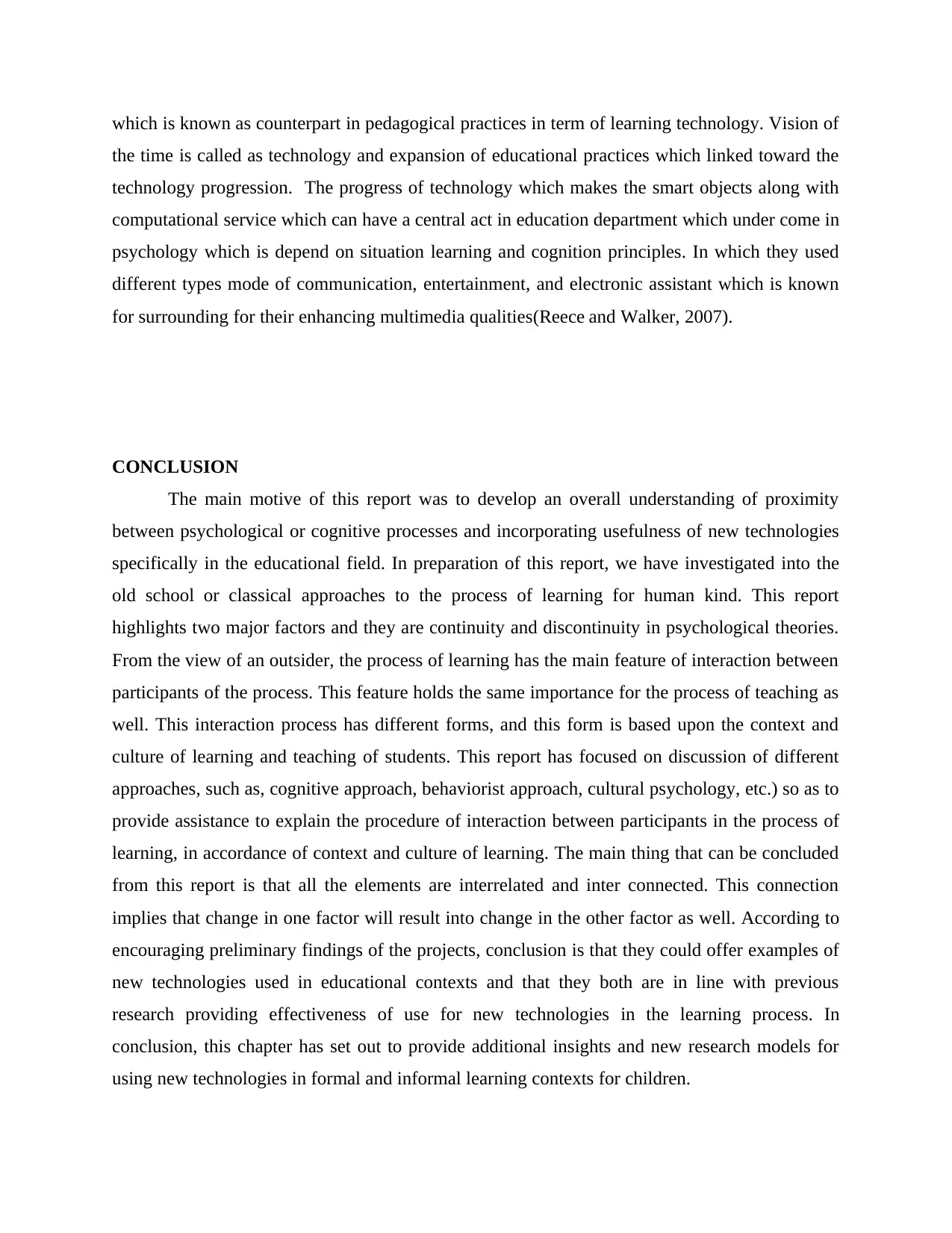
which is known as counterpart in pedagogical practices in term of learning technology. Vision of
the time is called as technology and expansion of educational practices which linked toward the
technology progression. The progress of technology which makes the smart objects along with
computational service which can have a central act in education department which under come in
psychology which is depend on situation learning and cognition principles. In which they used
different types mode of communication, entertainment, and electronic assistant which is known
for surrounding for their enhancing multimedia qualities(Reece and Walker, 2007).
CONCLUSION
The main motive of this report was to develop an overall understanding of proximity
between psychological or cognitive processes and incorporating usefulness of new technologies
specifically in the educational field. In preparation of this report, we have investigated into the
old school or classical approaches to the process of learning for human kind. This report
highlights two major factors and they are continuity and discontinuity in psychological theories.
From the view of an outsider, the process of learning has the main feature of interaction between
participants of the process. This feature holds the same importance for the process of teaching as
well. This interaction process has different forms, and this form is based upon the context and
culture of learning and teaching of students. This report has focused on discussion of different
approaches, such as, cognitive approach, behaviorist approach, cultural psychology, etc.) so as to
provide assistance to explain the procedure of interaction between participants in the process of
learning, in accordance of context and culture of learning. The main thing that can be concluded
from this report is that all the elements are interrelated and inter connected. This connection
implies that change in one factor will result into change in the other factor as well. According to
encouraging preliminary findings of the projects, conclusion is that they could offer examples of
new technologies used in educational contexts and that they both are in line with previous
research providing effectiveness of use for new technologies in the learning process. In
conclusion, this chapter has set out to provide additional insights and new research models for
using new technologies in formal and informal learning contexts for children.
the time is called as technology and expansion of educational practices which linked toward the
technology progression. The progress of technology which makes the smart objects along with
computational service which can have a central act in education department which under come in
psychology which is depend on situation learning and cognition principles. In which they used
different types mode of communication, entertainment, and electronic assistant which is known
for surrounding for their enhancing multimedia qualities(Reece and Walker, 2007).
CONCLUSION
The main motive of this report was to develop an overall understanding of proximity
between psychological or cognitive processes and incorporating usefulness of new technologies
specifically in the educational field. In preparation of this report, we have investigated into the
old school or classical approaches to the process of learning for human kind. This report
highlights two major factors and they are continuity and discontinuity in psychological theories.
From the view of an outsider, the process of learning has the main feature of interaction between
participants of the process. This feature holds the same importance for the process of teaching as
well. This interaction process has different forms, and this form is based upon the context and
culture of learning and teaching of students. This report has focused on discussion of different
approaches, such as, cognitive approach, behaviorist approach, cultural psychology, etc.) so as to
provide assistance to explain the procedure of interaction between participants in the process of
learning, in accordance of context and culture of learning. The main thing that can be concluded
from this report is that all the elements are interrelated and inter connected. This connection
implies that change in one factor will result into change in the other factor as well. According to
encouraging preliminary findings of the projects, conclusion is that they could offer examples of
new technologies used in educational contexts and that they both are in line with previous
research providing effectiveness of use for new technologies in the learning process. In
conclusion, this chapter has set out to provide additional insights and new research models for
using new technologies in formal and informal learning contexts for children.

⊘ This is a preview!⊘
Do you want full access?
Subscribe today to unlock all pages.

Trusted by 1+ million students worldwide
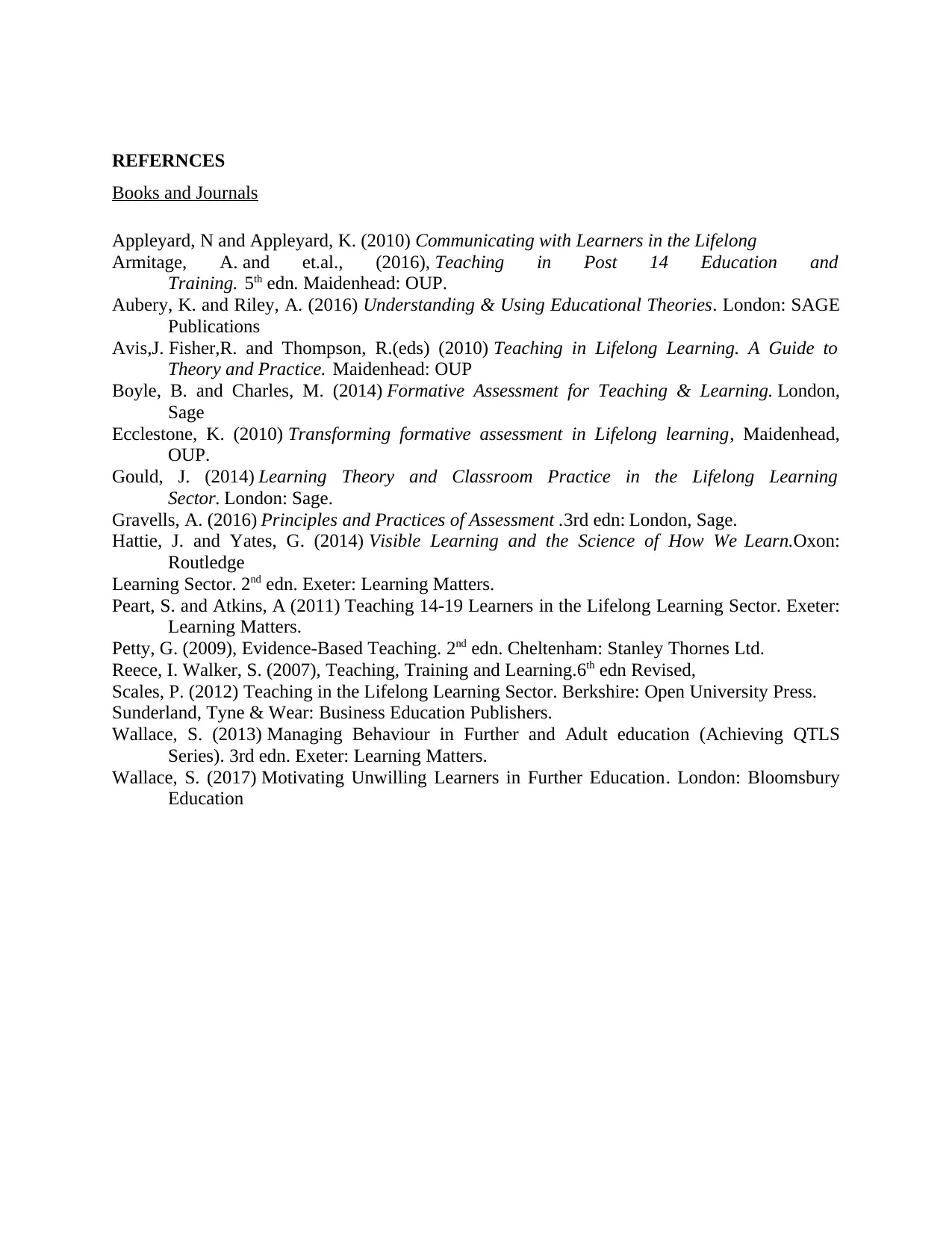
REFERNCES
Books and Journals
Appleyard, N and Appleyard, K. (2010) Communicating with Learners in the Lifelong
Armitage, A. and et.al., (2016), Teaching in Post 14 Education and
Training. 5th edn. Maidenhead: OUP.
Aubery, K. and Riley, A. (2016) Understanding & Using Educational Theories. London: SAGE
Publications
Avis,J. Fisher,R. and Thompson, R.(eds) (2010) Teaching in Lifelong Learning. A Guide to
Theory and Practice. Maidenhead: OUP
Boyle, B. and Charles, M. (2014) Formative Assessment for Teaching & Learning. London,
Sage
Ecclestone, K. (2010) Transforming formative assessment in Lifelong learning, Maidenhead,
OUP.
Gould, J. (2014) Learning Theory and Classroom Practice in the Lifelong Learning
Sector. London: Sage.
Gravells, A. (2016) Principles and Practices of Assessment .3rd edn: London, Sage.
Hattie, J. and Yates, G. (2014) Visible Learning and the Science of How We Learn.Oxon:
Routledge
Learning Sector. 2nd edn. Exeter: Learning Matters.
Peart, S. and Atkins, A (2011) Teaching 14-19 Learners in the Lifelong Learning Sector. Exeter:
Learning Matters.
Petty, G. (2009), Evidence-Based Teaching. 2nd edn. Cheltenham: Stanley Thornes Ltd.
Reece, I. Walker, S. (2007), Teaching, Training and Learning.6th edn Revised,
Scales, P. (2012) Teaching in the Lifelong Learning Sector. Berkshire: Open University Press.
Sunderland, Tyne & Wear: Business Education Publishers.
Wallace, S. (2013) Managing Behaviour in Further and Adult education (Achieving QTLS
Series). 3rd edn. Exeter: Learning Matters.
Wallace, S. (2017) Motivating Unwilling Learners in Further Education. London: Bloomsbury
Education
Books and Journals
Appleyard, N and Appleyard, K. (2010) Communicating with Learners in the Lifelong
Armitage, A. and et.al., (2016), Teaching in Post 14 Education and
Training. 5th edn. Maidenhead: OUP.
Aubery, K. and Riley, A. (2016) Understanding & Using Educational Theories. London: SAGE
Publications
Avis,J. Fisher,R. and Thompson, R.(eds) (2010) Teaching in Lifelong Learning. A Guide to
Theory and Practice. Maidenhead: OUP
Boyle, B. and Charles, M. (2014) Formative Assessment for Teaching & Learning. London,
Sage
Ecclestone, K. (2010) Transforming formative assessment in Lifelong learning, Maidenhead,
OUP.
Gould, J. (2014) Learning Theory and Classroom Practice in the Lifelong Learning
Sector. London: Sage.
Gravells, A. (2016) Principles and Practices of Assessment .3rd edn: London, Sage.
Hattie, J. and Yates, G. (2014) Visible Learning and the Science of How We Learn.Oxon:
Routledge
Learning Sector. 2nd edn. Exeter: Learning Matters.
Peart, S. and Atkins, A (2011) Teaching 14-19 Learners in the Lifelong Learning Sector. Exeter:
Learning Matters.
Petty, G. (2009), Evidence-Based Teaching. 2nd edn. Cheltenham: Stanley Thornes Ltd.
Reece, I. Walker, S. (2007), Teaching, Training and Learning.6th edn Revised,
Scales, P. (2012) Teaching in the Lifelong Learning Sector. Berkshire: Open University Press.
Sunderland, Tyne & Wear: Business Education Publishers.
Wallace, S. (2013) Managing Behaviour in Further and Adult education (Achieving QTLS
Series). 3rd edn. Exeter: Learning Matters.
Wallace, S. (2017) Motivating Unwilling Learners in Further Education. London: Bloomsbury
Education
1 out of 10
Related Documents
Your All-in-One AI-Powered Toolkit for Academic Success.
+13062052269
info@desklib.com
Available 24*7 on WhatsApp / Email
![[object Object]](/_next/static/media/star-bottom.7253800d.svg)
Unlock your academic potential
Copyright © 2020–2025 A2Z Services. All Rights Reserved. Developed and managed by ZUCOL.





